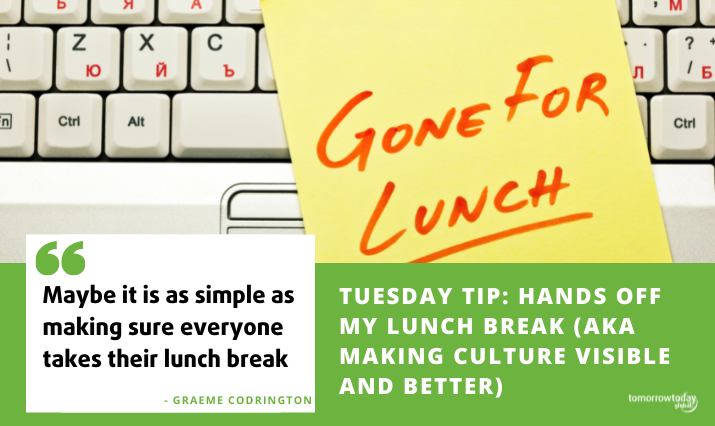The question: How do we deal with our culture while our team is not in the office together – it feels like we are losing something in this virtual, remote world?
The answer: Make culture visible
Too many people think that culture is something that can’t be worked on, changed and improved quickly. We maybe think that our culture “is what it is” and we just have to live with it. Or, we think that culture change – especially in large organisations – only happens with massive change management programs over an extended period of time. There’s some truth to the fact that culture change happens over time – but you can get some quick wins quite easily if you just make culture visible and deliberately work on it.
My colleague, Zanele Njapha recently brought to my attention something that Unilever have implemented during Lockdown. They call it: Hands Off My Lunch Break! They want to incentivise employee wellness, and normalise people being able to take a breather during the workday, so they have given everyone – from top to bottom – permission to say “I can’t do that now, I am taking a lunch break”. They’re allowed to decline meeting requests, ignore messages and tell people that they’re busy.
I was so excited about this, I recorded a video to motivate our clients to do something similar. It’s just 2.5 minutes – watch it and share it with your friends.
This is a good example of “making culture visible”. There are three things to do here:
- Decide on the cultural attributes you want your team to exhibit. Notice that I am not using the language of “mission”, “vision” or “values” here. Your company might have defined these, but you need to go beyond just a few nebulous concept words (like “trust”, “integrity” or “respect”) and select actions, activities, attitudes and behaviours that can be measured and identified in people. In Unilever’s case, the underlying company value might have been about respect. They might have also said they valued employee wellbeing. But then they went further and were clear about what that actually looks like.
- Discuss and normalise these cultural attributes, especially those that are aspirational. In other words, don’t be scared to identify when you as a team might not be getting these things right, and talk about what it would look and feel like to work in an environment when you were doing these things regularly. These will be motivating and inspiring conversations. They should happen regularly. Culture is not something you “do”, it’s something you live. It’s not a destination, it is an ongoing journey. So when you feel your team has mastered one of the cultural attributes you’re working on, you move onto the next. Continuous improvement is the goal.
- Give everyone in the team permission to be custodians of the culture. This is very important. The most junior person should be able to call out the CEO if they feel the “big boss” has not adhered to the agreed culture. For example, if you agree that “showing respect” means that we greet and acknowledge each other when we see each other, then if the CEO rushed through the reception area and doesn’t greet the security guard, the guard can call her out and remind her that she should do so. Obviously, this should be done respectfully and maybe even with a bit of humour, but if we’ve had discussions about what culture we want, and we’ve agreed on certain cultural attributes, then we need to ensure that everyone is invested in making them a reality – in making culture visible.
Yes, it’s more complicated than this Tuesday Tip makes out. And, yes, our team can help your team to go through a scientifically structured and proven process to identify your current culture by doing a cultural stocktake, define your future aspirational culture and select the very best cultural attributes that will make all the difference for you and your team.
If you’d like to listen to a 30 minute podcast interview on this topic with one of our associates, Steve Simpson, click here. If this all sounds like it could help you, contact us to find out more.
But, you don’t need our help to just make a start on making your culture visible. You can start the three steps above today with your team. And who knows: maybe it is as simple as making sure everyone takes their lunch break.
Author of today’s tip, Graeme Codrington, is an internationally recognized futurist, specializing in the future of work. He helps organizations understand the forces that will shape our lives in the next ten years, and how we can respond in order to confidently stay ahead of change.
For the past two decades, Graeme has worked with some of the world’s most recognized brands, travelling to over 80 countries in total, and speaking to around 100,000 people every year. He is the author of 5 best-selling books, and on faculty at 5 top global business schools.



Trackbacks/Pingbacks